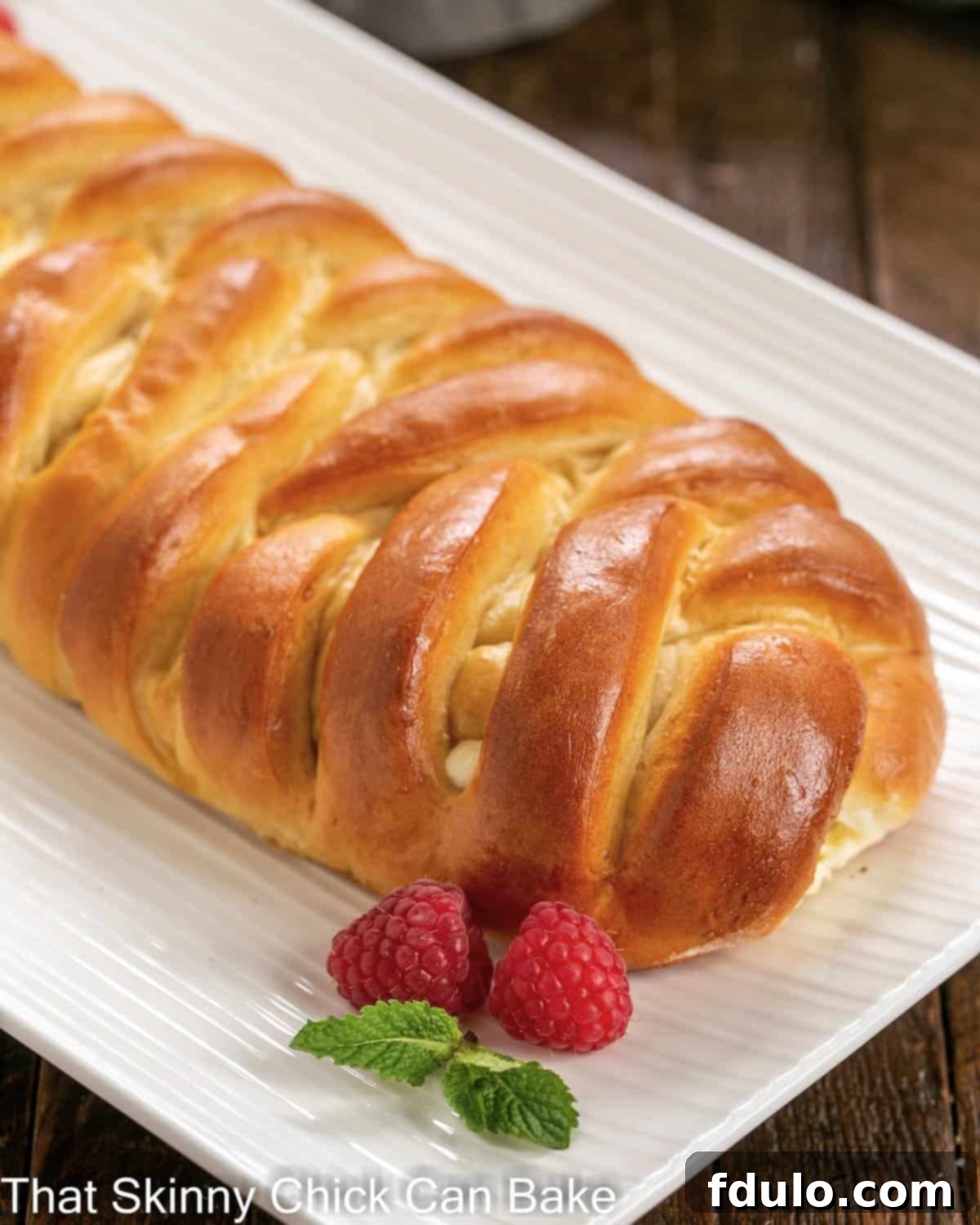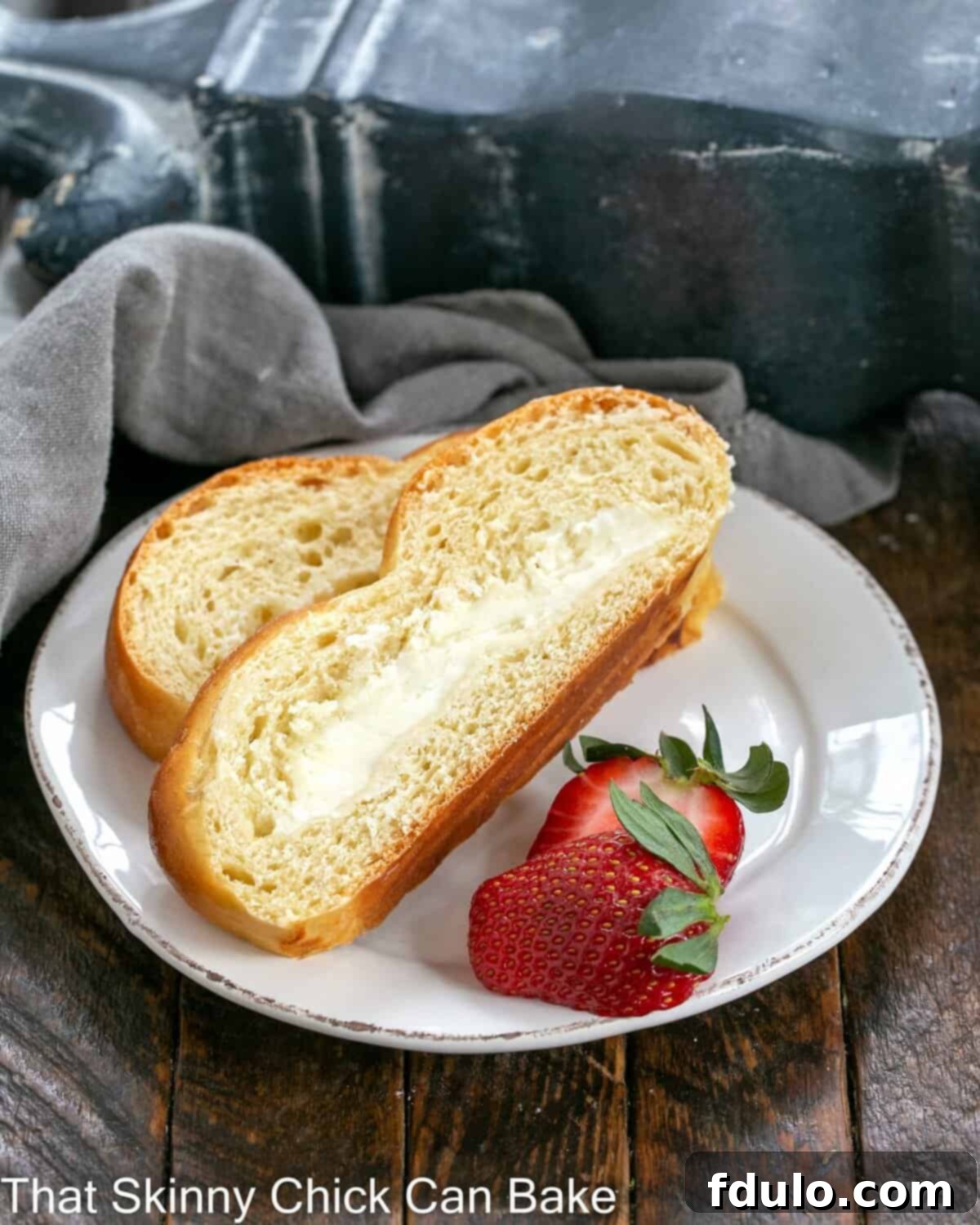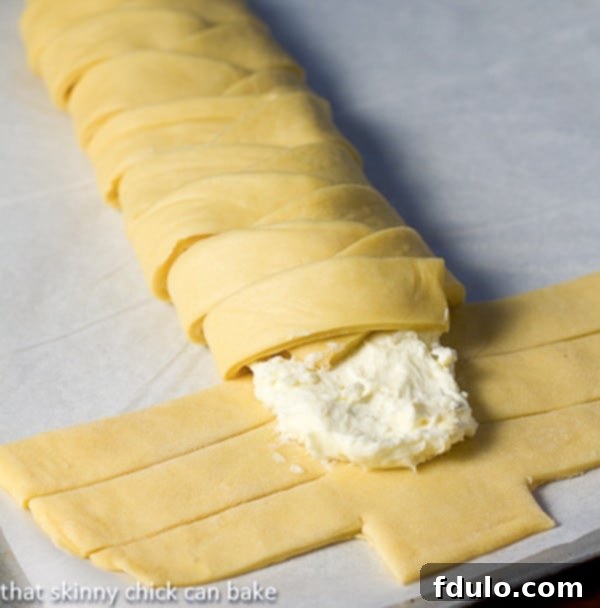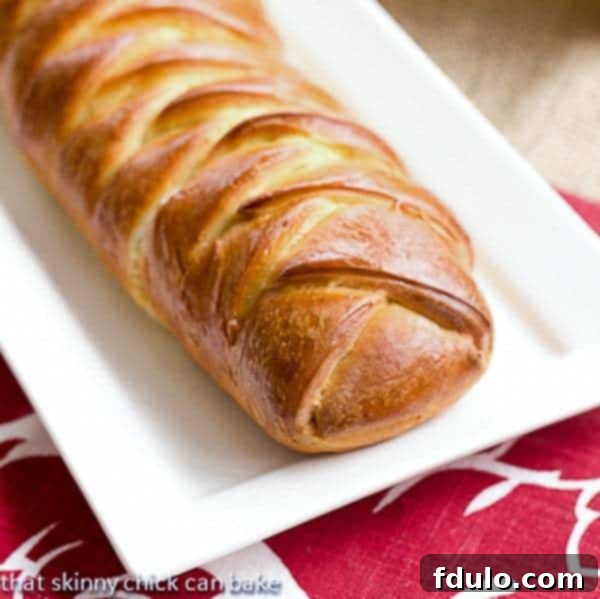Indulge in the true spirit of the holidays with a treat that’s as delightful to bake as it is to eat. This exquisitely buttery and tender Plaited Easter Bread with Cream Cheese Filling is more than just a recipe; it’s a cherished family tradition, a perfect holiday indulgence that brings warmth and joy to any Easter celebration.
This magnificent Easter Recipe transforms simple ingredients into a show-stopping centerpiece, ideal for a comforting bedtime snack after the solemn Easter Vigil Mass or as the star of your Easter morning breakfast or brunch spread. Its rich flavor and beautiful presentation make it a memorable addition to your festive table.

Why This Cream Cheese Filled Easter Bread is a Must-Bake This Season
There are countless reasons to add this exquisite plaited Easter bread to your holiday baking repertoire. From its inviting aroma to its irresistible flavor, every aspect of this recipe promises a rewarding experience. Here’s why this particular bread is destined to become a beloved tradition in your home:
- Effortlessly Soft and Manageable Dough: The foundation of any great bread is its dough, and this recipe delivers a dough that is incredibly soft, enriched with butter, and a true pleasure to work with. It’s forgiving for beginners yet satisfying for experienced bakers, ensuring a delightful texture in every bite.
- Deceptively Simple Braiding Technique: Don’t let the elegant appearance fool you. While it looks impressively intricate, the braiding method for this bread is surprisingly straightforward, involving a simple criss-cross pattern of dough strips over the filling. It’s a technique that yields stunning results without requiring advanced baking skills, making you look like a seasoned artisan!
- Luxurious Cream Cheese Filling Elevates the Experience: What truly sets this Easter bread apart is its decadent cream cheese filling. Sweet, tangy, and incredibly creamy, it transforms a simple sweet bread into a special occasion delicacy. It’s the perfect complement to the rich, brioche-like dough, making it absolutely ideal for a festive holiday breakfast or an elegant brunch gathering.
- A Recipe for Cherished Memories: Beyond the taste, baking this bread creates wonderful memories. The process of mixing, shaping, and baking, followed by the shared joy of savoring it with loved ones, is what holidays are all about. It’s a tradition in the making, promising warmth, comfort, and deliciousness year after year.
Essential Ingredient Notes for a Perfect Loaf
Crafting the perfect plaited Easter bread begins with understanding the role of each ingredient. Quality ingredients make a noticeable difference in flavor and texture. Here’s what you need to know to ensure your bread turns out beautifully:
- Kitchen Staples: You’ll need lukewarm water to activate the yeast, a pinch of salt to enhance the flavors, high-quality all-purpose flour for the perfect structure, and milk for richness and tenderness. Ensure your flour is unbleached for the best results.
- Dry Active Yeast: One packet, typically 2¼ teaspoons, is sufficient. Using a reliable brand like Red Star Yeast ensures consistent activation and a good rise for your dough. Always check the expiry date!
- Eggs: Two lightly beaten eggs are incorporated into the dough, providing richness, color, and structure. An additional egg beaten with water creates the perfect egg wash, giving your baked bread that beautiful, golden-brown sheen.
- Honey: This natural sweetener adds a unique depth of flavor and helps with the browning of the crust. If you have access to local honey, it’s a wonderful choice, and some believe it can offer benefits for seasonal allergies.
- Unsalted Butter: You’ll need butter in two forms: part melted for easy incorporation into the dough, contributing to its tender texture, and part at room temperature for the filling. Using unsalted butter allows you to control the overall saltiness of the recipe.
- Cream Cheese: For a smooth, lump-free filling, it’s crucial that your cream cheese is at room temperature before blending. The Philadelphia brand is a popular choice for its consistent quality and creamy texture.
- Lemon Juice: Freshly squeezed lemon juice brightens the flavor of the cream cheese filling, adding a delightful zesty note that cuts through the richness. Avoid bottled lemon juice for the best taste.
- Powdered Sugar: Essential for the sweet glaze, sift powdered sugar before mixing to prevent lumps and achieve a silky-smooth icing that drizzles beautifully over the cooled bread.
- Vanilla Extract: Always opt for real vanilla extract, not artificially flavored substitutes. A high-quality brand like Nielsen-Massey will impart a superior, authentic vanilla flavor to both the bread and the icing.

Tested and Approved: Rave Reviews for This Easter Bread
Don’t just take our word for it! This recipe has been tried, tested, and loved by many, receiving enthusiastic endorsements. As my friend Kathy shared via Facebook, after tasting it, she declared, “So delicious – verified taster!” This feedback highlights the consistent quality and deliciousness you can expect when you bake this special holiday bread.
Step-by-Step Guide: Crafting Your Perfect Plaited Easter Bread
When I think of Easter, my mind instantly conjures images of freshly baked, sweet rolls, often drizzled with a simple frosting, that we eagerly devoured before heading to bed. With full, happy stomachs, we’d drift off to sleep, knowing that delicious leftovers awaited us for breakfast. As Easter approached this year, I felt a strong desire to recreate that comforting tradition, but with a new twist: a rich, egg-based bread, generously filled with creamy goodness. I consulted my trusted Artisan Bread in Five Minutes a Day (affiliate link) cookbook and debated between brioche and challah doughs, ultimately deciding that the rich, versatile challah-style dough would be perfect for this indulgent creation.
Here’s how you can make this beautiful and delicious plaited Easter bread:
- Prepare the Dough: Begin by combining all the dough ingredients in the bowl of a stand mixer fitted with a dough hook. Mix until everything is well incorporated and the dough comes together. Once mixed, cover the bowl with a clean cloth and allow the dough to rest at room temperature for an initial 2-hour proofing period. This allows the yeast to activate and the flavors to develop.
- Chill or Use Immediately: After the initial rise, the dough is incredibly versatile. You can either use half of it immediately to bake your first loaf or refrigerate it for up to 5 days, making it perfect for preparing ahead of time. This flexibility is a hallmark of “no-knead” style doughs and makes holiday baking much less stressful. You’ll only need half the dough for one loaf, so you’ll have enough for another delicious creation later!
- Roll Out the Dough: Lightly flour a clean work surface and gently roll out half of the dough into a rectangular shape, approximately 8 x 12 inches. Aim for an even thickness across the entire rectangle to ensure uniform baking.
- Prepare and Spread the Filling: In a separate bowl, whisk together the room-temperature cream cheese, sugar, softened butter, and a hint of fresh lemon juice until the mixture is completely smooth and creamy. Carefully spread this luscious filling down the middle 3 inches of your rolled-out dough, leaving wide, even borders on each side. These borders are crucial for sealing the filling within the braid.
- Cut the Dough Strips: Using a sharp knife or a pizza cutter, cut diagonal or straight slits along each of the wide borders you left on either side of the filling. Each strip should be about 1½-inches wide. Ensure the cuts reach almost to the edge of the filling but do not cut through the middle section, which holds the filling.
- Begin the Plaiting (Braiding): Starting at one end of the rectangle, gently take one dough strip from one side and fold it over the cream cheese filling, pressing lightly to secure it. Then, take a strip from the opposite side and fold it over the first strip, creating a criss-cross pattern. Continue this process, alternating sides, working your way down the length of the loaf until all the filling is beautifully covered by the plaited dough strips.
- Final Proof and Bake: Once braided, transfer the loaf to a parchment-lined baking sheet. Cover it loosely with a dishcloth and allow it to rest again for another proofing period, typically around 1 hour and 20 minutes, or longer if your dough was refrigerated. This allows the dough to rise and become light and airy. Preheat your oven to 350°F (175°C). Brush the top of the loaf with the egg wash for a golden, glossy finish, then bake for approximately 30 minutes, or until deeply golden brown and cooked through. This is truly one of those amazing Easter Recipes that is destined to become a cherished tradition.
- Cool and Glaze: Once baked, remove the bread from the oven and let it cool on a wire rack. While it cools, prepare a simple glaze by whisking powdered sugar, a touch of melted butter, a splash of milk, and a dash of vanilla extract until smooth. Drizzle generously over the cooled bread for an extra touch of sweetness and shine.

Precisely cut strips on each side, leaving the center intact for the delicious filling. Once the filling is placed, gracefully criss-cross the strips over the center to create a stunning plaited design.
Frequently Asked Questions About Easter Bread
Easter bread holds deep symbolic meaning rooted in Christian traditions, representing rebirth, renewal, and the resurrection of Jesus Christ. The rising of leavened Easter bread beautifully reflects Jesus rising from the dead, symbolizing hope and new life. Furthermore, the eggs often incorporated into the dough or nestled within the bread celebrate rebirth and the arrival of a new season following the departure of Lent, a period of fasting and reflection. Many Easter bread recipes are shaped into a wreath or ring, which is often said to represent Jesus’ crown of thorns, but also eternal life, signifying no beginning or end. This profound symbolism transforms a simple loaf of bread into a powerful and meaningful part of the Easter celebration, connecting generations through shared faith and tradition.
Easter is a holiday rich with diverse culinary traditions, and many nationalities boast their own unique and delicious versions of Easter bread. These breads often reflect local ingredients, cultural customs, and symbolic shapes. Here are just a few examples of the wide array of Easter breads enjoyed around the world:
- Babka: A sweet, brioche-like yeast cake, often swirled with chocolate, cinnamon, or fruit, popular in Poland and other Central and Eastern European countries. Its name means “grandmother,” referring to its crinkled, skirt-like shape.
- Zozukak: A traditional Bulgarian Easter bread, typically a sweet, braided loaf often decorated with dyed eggs.
- Pinea (Pinca): A fragrant, sweet bread from Croatia, often flavored with citrus zest and rum, known for its round shape and scored top.
- Pane di Pasqua: Italian Easter bread, which varies regionally but often features a braided dough, sometimes incorporating colorful dyed eggs baked right into the loaf, signifying rebirth.
- Kulich: A tall, cylindrical Russian Easter bread, rich with eggs and butter, often decorated with white icing and “XB” (for “Christos Voskrese,” Christ is Risen).
- Osterbrot: A German Easter bread, typically a rich, sweet yeast bread, often with raisins and candied fruit, served for breakfast on Easter morning.
- Paska: A traditional Ukrainian Easter bread, intricately braided and decorated, often topped with religious symbols made from dough. It is a symbol of great significance and prosperity.
Each of these breads, while unique, shares the common thread of celebrating the joy and renewal of Easter.

Expand Your Holiday Baking: More Delicious Recipes
If you’ve enjoyed baking and tasting this delightful Plaited Easter Bread, you might be looking for more recipes to enhance your holiday menu or simply explore new bread-making adventures. Here are some other fantastic recipes that celebrate the art of baking and the joy of sharing:
- Greek Easter Bread by Alice at Hip Foodie Mom: Discover another wonderful variation of traditional Easter bread, rich in flavor and cultural heritage.
- Italian Pizza Rustica: A savory alternative, this hearty Italian “pizza” (pie) is often made during Easter and features a rich filling of cheeses and cured meats.
- Plus my Braided Easter Bread: For another take on a classic braided loaf, this recipe offers a simpler approach without the filling, perfect for a lighter sweet bread.
- More of my best Bread Recipes: Explore a wide collection of my favorite bread recipes, from everyday loaves to special occasion delights, all designed to inspire your inner baker.
Stay connected and share your culinary creations with me through social media! Find me on Instagram, Facebook, and Pinterest. Don’t forget to tag me when you try one of my delicious recipes! Your feedback is invaluable, and if you love the results as much as I do, please take a moment to give it a 5-star rating in the recipe card below. Happy baking!

Plaited Easter Bread with Cream Cheese Filling
45 minutes
30 minutes
1 hour 15 minutes
1 braided loaf plus dough for another loaf
A delightful bread recipe inspired by Artisan Bread in Five Minutes a Day by Jeff Hertzberg and Zoe Francois, perfected with a luscious cream cheese filling.
Ingredients
For the Dough:
- ¾ cup + 2 tablespoons lukewarm water
- 2 ¼ teaspoons dry active yeast (1 packet)
- 2 ¼ teaspoons salt
- 2 eggs, lightly beaten
- ¼ cup honey
- ¼ cup unsalted butter, melted
- 3 ½ cups unbleached all-purpose flour
For the Egg Wash:
- 1 egg beaten with 1 tablespoon of water
For the Cream Cheese Filling:
- 8 ounces cream cheese, at room temperature
- ¼ cup granulated sugar
- 1 tablespoon unsalted butter, at room temperature
- 1 teaspoon fresh lemon juice
For the Icing:
- Powdered sugar, unsalted butter, milk, and vanilla extract (amounts to taste for desired consistency)
Instructions
- In the bowl of your stand mixer, combine the lukewarm water, dry active yeast, salt, lightly beaten eggs, honey, and melted butter. Mix well to combine.
- Add the unbleached all-purpose flour to the wet ingredients. Using a dough hook attachment, mix until the flour is fully incorporated and a cohesive dough forms.
- Cover the dough bowl with a clean kitchen cloth and allow it to rest at room temperature for approximately 2 hours. This initial rise is crucial for developing flavor and texture.
- After the initial rise, the dough can be used immediately or stored in a covered container in the refrigerator for up to 5 days. For longer storage, the dough can be frozen.
- When you are ready to bake, line a baking sheet with parchment paper. Lightly dust your work surface and the dough with flour to prevent sticking.
- Take half of the dough and roll it out into a rectangle approximately 8 inches by 12 inches. Return the other half of the dough to a covered container in the refrigerator for future use.
- Cut slits along both longer sides of the dough, cutting towards the middle. Each slit should be about 1 ½-inches wide. Leave an uncut strip of dough, roughly 3 inches wide, running down the center of the rectangle.
- Refer to the provided photo for a visual guide. For easier braiding, I sometimes trim and remove a small amount of extra dough from both ends of the rectangle, but this step is entirely optional.
- Prepare the filling: In a small bowl, mix together the room-temperature cream cheese, granulated sugar, softened butter, and fresh lemon juice until smooth and creamy. Spread this filling evenly down the center, uncut strip of the dough. Then, begin to plait (braid) the strips by crossing one strip over the filling from one side, then an alternating strip from the other side, overlapping them at a slight angle until the entire filling is covered.
- Cover the braided loaf loosely with a clean dishcloth and let it rest for a second proofing, approximately 1 hour and 20 minutes. If your dough was cold from the refrigerator, allow for additional resting time.
- Preheat your oven to 350ºF (175ºC). Lightly brush the top and sides of the loaf with the prepared egg wash (1 egg beaten with 1 tablespoon of water) for a beautiful golden crust.
- Bake the plaited Easter bread on the center rack of the oven for about 30 minutes, or until it is golden brown and sounds hollow when tapped. Let it cool on a wire rack. Once cooled, ice as desired with a simple glaze made from powdered sugar, butter, milk, and vanilla.
Notes
Yield: This recipe makes 1 beautiful plaited loaf and provides approximately 1 pound of versatile bread dough for a second loaf of your choice, to be baked later.
Please note: The total time listed in the recipe card does not include the essential proofing times for the dough, which are crucial for the bread’s texture and flavor.
Recommended Products
As an Amazon Associate and member of other affiliate programs, I earn from qualifying purchases.
- Red Star Platinum Yeast (Instant Yeast)
- Smithcraft Stainless Steel Measuring Cups Set
- KitchenAid KSM150PSER Artisan Tilt-Head Stand Mixer with Pouring Shield, 5-Quart, Empire Red
Nutrition Information:
Yield:
12
Serving Size:
1 slice
Amount Per Serving:
Calories: 361Total Fat: 14gSaturated Fat: 8gTrans Fat: 0gUnsaturated Fat: 5gCholesterol: 79mgSodium: 529mgCarbohydrates: 52gFiber: 1gSugar: 24gProtein: 8g
Please note: My nutrition calculator took into account the other half of the bread dough that’s not used in this single loaf recipe. Therefore, the caloric and nutritional values may appear higher than they would for just one loaf.
HOW MUCH DID YOU LOVE THIS RECIPE?
Please leave a comment on the blog or share a photo on Pinterest

